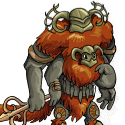|
ProfessorCirno posted:You haven't explained how defenders work. YOu said "They stand there and the monsters all attack." My response has never been "I've never seen that happen". You may be conflating me with another poster, perhaps on another board. What I have said is that there are games where this does not happen. There is a very important difference, which is that I am acknowledging the existence of two different playstyles. I have GMed games following both playstyles. Presently I GM a Pathfinder game where I consider which PC the monster will consider the best target based on its mindset and positioning. This is a battlemat-less game, so "I'll have to go through the barbarian to get to the bard" is a concern, especially as I do not consider it reasonable for many enemies to just accept a Power Attack to the back of the head as the necessary cost of getting to a character who may or may not be a wizard. The players are also heavy roleplayers and select their targets similarly - even if the player knows his character will survive the AoO, they will consider whether the character is motivated to take the risk. This largely follows a grognard model; a number of the players haven't played any significant amount since mid-2E (and the game is actually an adaptation of a 2E module). The game before this was a 4E game using a battlemat, where tactical movement was a larger consideration. Because 4E has mark and taunt mechanics baked in, the players were comfortable playing with a more gamist and less narrative mindset where the calculations about AoOs were made along much the same line you describe - but that was a different group with different tastes. I'm fortunate enough to generally play with people I know and be able to run a game to their tastes. quote:If your GM has never had a monster just ignore the presence of an AoO, then your GM is...pretty smart since AoO are really loving annoying. On the other hand, it also means that you're just sorta ignoring the rules. Above a certain level, 3.5/PF runs to an increasing degree on the basis of ignoring the rules. quote:As for the Pathfinder developers, they know less about their own game then probably anyone in this thread does. Agreed. Or, at least, anyone in this thread who knows that little freely admits it. quote:What most likely happens is that the DM never even thinks about having a monster just ignore the fighter. This is fine! It's how 3e works, quite frankly. This is pretty much exactly what I said about a gentleman's contract that grognards don't even recognize they are enforcing.  quote:The problem is that this means the fighter exists entirely based on DM Fiat, and it means that in a purely mechanical way that Defenders do not exist. Which is a problem for some games, and not for others. quote:Funny enough they actually DID exist in 3.5, where a feat let fighters immobilize enemies they hit with an AoO. Stand Still would be a nice feat to port forwards, yeah. I am pretty sure you are conflating me with one or more other posters, ProfessorCirno, given that at least a few of your points pretty much exactly mirror things I said in previous posts. Please don't take out your predisposition to rage at someone else on me, it's kind of annoying.
|
|
|
|

|
| # ? May 21, 2024 01:23 |
|
Reicere posted:Ok, bottom to top here. quote:Which is a problem for some games, and not for others. quote:I have GMed games following both playstyles. Presently I GM a Pathfinder game where I consider which PC the monster will consider the best target based on its mindset and positioning. This is a battlemat-less game, so "I'll have to go through the barbarian to get to the bard" is a concern, especially as I do not consider it reasonable for many enemies to just accept a Power Attack to the back of the head as the necessary cost of getting to a character who may or may not be a wizard. The players are also heavy roleplayers and select their targets similarly - even if the player knows his character will survive the AoO, they will consider whether the character is motivated to take the risk. This largely follows a grognard model; a number of the players haven't played any significant amount since mid-2E (and the game is actually an adaptation of a 2E module). MadScientistWorking fucked around with this message at 15:33 on Oct 15, 2011 |
|
|
|
OpenlyEvilJello posted:Pawsplay, I feel like some of your issues with marking are issues with class-based systems in general. I don't mean this as criticism, but why is a mark unsuitable for a class feature but, say, sneak attack is? That is, what is that separates marking from existing class features that you do accept (assuming, of course, that you accept sneak attack as a fitting class feature)? Sneak attack seems to refer to something specific. It seems to describe an identifiable skill, it functions consistently in different contexts, and reinforces both the narrative contexts and the strategies of backstabbers. Marking, on the other hand, is slightly more abtract, tactically only describes a few specific situations, and seems to describe something I think is a little weird. Some people wonder why monsters don't just run past fighters in 3.5, based on the mechanics; I wonder monsters stick like glue to fighters in 4e because of marking. Marking actually does seem to represent some kind of "gentleman's agreement" in that it is manufactured to give defenders (and apparently a few other character types) a special job to do. I can also represent some in-game things that would logically draw attention, but doesn't clearly map to those things and sometimes clearly does not... Sneak attack is shared by several classes, though the only core base class with it is the rogue. True20 treats it as a feat, Fantasy Craft divvies it up between a few class features, but mostly feats and also some skill checks. There is really no perfect answer. I simply don't view Marking as something that should happen so consistently it should be a class feature of defenders. By contrast, a Fighter's improved opportunity attack abilities in 4e make a certain kind of sense. That actually seems to describe "defending" rather than just decreeing it. It's true, 3e and Pathfinder have few explicit "marking" mechanics, and that is actually my preference. However, I usually prefer marking to force-taunts unless the forced taunt, again, is generalizable to several contexts. I don't like Fantasy Craft's version of the Taunt because in some situations, it turns enemies into stupids. Just because an enemy wizard is enraged does not mean he's going to run over and punch you. So, going back to Pathfinder, my preference for handling the defender role is to focus on abilities that improve AoOs, reactions and readied actions, and to inflict situational penalties on opponents. The Cavalier's challenge ability is the farthest edge of what I really find attractive in a mechanic, but I'm okay with it because, first of all, it works pretty well mechanically, second, because the flavor of Cavaliers implies something perhaps more than ordinary prowess, third, because it affects primarily the Cavalier and is thus plausible as an ability and generalizable, and fourth, because it is class-specific it is up to the GM and players whether they want to emphasize that kind of mechanic in play.
|
|
|
|
MadScientistWorking posted:I think this is the reason why Cirno is getting annoyed at you. You are essentially arguing that because you have to jump through hoops to make the game work there is no problem with the game. I'm sorry that it comes off like that. What I'm taking issue with is the claim that anyone who thinks it can work is absolutely wrong. It works for certain games, and does not work for others, as I acknowledge in every single post I have made on the subject. Seriously, not sure how much more clear I can make it that I acknowledge there's a problem for some people. quote:You still never actually responded to the fact that anyone with an once of common sense would know how marching orders work and would instinctively try and go after the people who are not in the front lines due to them always being the squishy artillery. Or rogues, or bards. Or archer-rangers. A given person on the second or third line is not necessarily the greatest immediate danger to you personally, especially if you do not take it as a given that every group of people on the planet will automatically have spellcasters in it. A group which also has ranged attackers in a game I run this way will also tend to prefer to let its ranged attackers focus on the enemy's back line since they can do it without getting a sword in the back of the head. There are a few assumptions which apply in my game here which may not apply in any given other game. First is that not every traveling group has mages in it. This seems to be the default assumption in most 3.5/PF settings: mages are common enough that you can find one to talk to in any major settlement if you need to, but rare enough that most people probably don't know one personally and don't assume that there's one around until the spells come out. If mages are common enough in your setting that every group of people that's wandering around will have one in it, and also universally an order of magnitude more dangerous than anyone else, this obviously changes. The second assumption is, to put it a way that may sound a bit snide, that getting hit with a sword hurts. That is to say, the assumption that a character who is not extremely disciplined and/or highly motivated is unlikely to go "welp, I've got 40 HP still and this guy probably won't do all of that if he whacks me while I go past, I bet I can chew on that other guy a little before I get stabbed in the back of the brain and die." Essentially, this is an assumption whereby marking in the football sense is an aspect of roleplay: the barbarian in your face may not be such a dominant factor that you lose all awareness of the battlefield, but you may evaluate him as something that requires your focus while someone else takes care of the rest of the situation. Now, once more for everyone else to not read and/or completely ignore: These are playstyle dependent and does not mean the problem does not exist in your game or that your playstyle is not valid. My argument is only that a valid playstyle also exists, and is used in a fair number of campaigns, where the situation I describe applies. Benly fucked around with this message at 21:07 on Oct 15, 2011 |
|
|
|
pawsplay posted:Sneak attack seems to refer to something specific. It seems to describe an identifiable skill, it functions consistently in different contexts, and reinforces both the narrative contexts and the strategies of backstabbers. Marking, on the other hand, is slightly more abtract, tactically only describes a few specific situations, and seems to describe something I think is a little weird. Some people wonder why monsters don't just run past fighters in 3.5, based on the mechanics; I wonder monsters stick like glue to fighters in 4e because of marking. Marking actually does seem to represent some kind of "gentleman's agreement" in that it is manufactured to give defenders (and apparently a few other character types) a special job to do. I can also represent some in-game things that would logically draw attention, but doesn't clearly map to those things and sometimes clearly does not... In Pathfinder there is an assumption that you can and will do anything that you aren't explicitly told you can't. Antagonize's Intimidate part will straight up make you move and melee attack if you fail the save. What situational penalties can a melee-specific guy use that would stop the Ogre from just strolling over and stomping the caster first thing? Or even worse the flying, invisible, demon-summoning, necromancer in his trapped hall. Is there more than trying to win initiative and be in the way?
|
|
|
pawsplay posted:Sneak attack seems to refer to something specific. . . . Some people wonder why monsters don't just run past fighters in 3.5, based on the mechanics; I wonder monsters stick like glue to fighters in 4e because of marking. Ultimately I suspect it's a difference in levels of abstraction. However, the second sentence I've retained here makes me think you might have misapprehended the role of 4e marking (monsters can and should violate a mark if it seems to suit their purposes; if a monster is stuck to a fighter it's probably because of the fighter's OA). This is pretty off-topic for this thread, though, so I'll leave it at that. pawsplay posted:Sneak attack is shared by several classes, though the only core base class with it is the rogue. True20 treats it as a feat, Fantasy Craft divvies it up between a few class features, but mostly feats and also some skill checks. This part seems to be in the vein of problems with class-based systems again. pawsplay posted:It's true, 3e and Pathfinder have few explicit "marking" mechanics, and that is actually my preference. However, I usually prefer marking to force-taunts unless the forced taunt, again, is generalizable to several contexts. I don't like Fantasy Craft's version of the Taunt because in some situations, it turns enemies into stupids. Just because an enemy wizard is enraged does not mean he's going to run over and punch you. I'm not a huge fan of taunts (by which I mean a mechanic that, by the rules, requires the target to attack the originator), either. There's no decision involved, so I don't find it interesting. By contrast, I like the mark mechanic because it does create a decision. But then, I enjoy the tactical skirmish elements of the game and reasonable minds may differ. pawsplay posted:So, going back to Pathfinder, my preference for handling the defender role is to focus on abilities that improve AoOs, reactions and readied actions, and to inflict situational penalties on opponents. I would love to see some of this stuff in the game (although I'm not sure I trust the devs to do it well).
|
|
|
|
|
OpenlyEvilJello posted:This part seems to be in the vein of problems with class-based systems again. I think there are situations where class-based systems can clash with thematics. That is basically the whole reason you have stuff like archetypes and variant class features and variant classes and so forth. For instance, in 3.0, rangers were two-weapon fighting experts, but a lot of people were unimpressed with that. I mean, rangers being woodsy and all, how about archery? So 3.5 basically said, "You know, you're right. That's thematically limiting. Here, have some archery as an option, too." My self-published Pathfinder product has a lot of material intended to deal with this issue, enabling character concepts that ordinarily run into a conflict between class features and thematics. So there's the Martial Artist, who can be configured as a non-magical Monk, or as an unarmored Fighter, or as a Kensai/Weapon Master type done as a base class. I like class-based games. However, I think one of the best things in gaming in the 21st century is that class-based games have started including a lot of modularity, while modular games (especially point-based ones) are making more use of templates and implicit roles. So, marking. To me it fits better as a specific configuration for a character with a specific rationale. I know a lot of people encountered marking and were like, "Aha! This is what I've been missing," but for me, it's definitely a case of something that is tasty as a spice getting used to cook everything.Given marking as a core design assumption, I think 4e did an excellent job of marrying this concept to those specific rationales for each class. And, as I said before, I think the Pathfinder Cavalier works well, too.
|
|
|
|
pawsplay posted:I think there are situations where class-based systems can clash with thematics. That is basically the whole reason you have stuff like archetypes and variant class features and variant classes and so forth. For instance, in 3.0, rangers were two-weapon fighting experts, but a lot of people were unimpressed with that. I mean, rangers being woodsy and all, how about archery? So 3.5 basically said, "You know, you're right. That's thematically limiting. Here, have some archery as an option, too." Gamerprinter?
|
|
|
|
Piell posted:Gamerprinter? Can't be. He's made posts that don't have the phrase "my Pathfinder setting, Kaidan: A Japanese Ghost Story" in them anywhere.
|
|
|
|
You do realize that the defender concept of "if you try to attack/move towards me and my crew, you are in for a world of poo poo" can be done by Wizards and Druids, right? Without requiring marks or any sort of metagame abilities? A Wall of Fire, Web, Entangle, or even a cleverly cast Silent Image works just as well as the dude in the full plate with an axe. This concept existed before the 4e paradigm, and really shouldn't be discussed under the 4e paradigm since PF isn't 4e. To go back to that tier list thing, let me take a stab at it. I'm going to use four groups, based on the power and versatility of class abilities: Omnipotent, Versatile, Singular, and Nothing. Omnipotent means very good, Versatile means pretty good, Singular means average, and Nothing means does not work. This is personal opinion, mind. Omnipotent: Wizards - Still have the most tricks. Their Arcane Discoveries can obviate basic game tenets if you're savvy (Craft Construct and the one that gives you a True Name). The Divination specialty is silly good, and most of the specializations are at least decent. Druid - The Polymorph/Wild Shape nerfs were painful, but necessary. They still act as force multipliers and might be better than Clerics when it comes to beating face. Cleric - They lost some things, they gained some things, but it balances out. Still generically awesome at everything. They're better Gishes than the Gish archetype. Witch - Wizards with focused spell lists and a bevy of awesome low-level abilities. Charm and Slumber by themselves would make them at least Versatile levels of good. Sorcerer - Wizards but worse. Arcane Bloodline almost gets rid of the "but worse". Oracle - Being spontaneous casters without major offensive abilities is usually a bad thing, but they have at least two options to get around that (Battle or Heavens Mysteries). You could do worse. Summoner - Sort of like a Druid Junior, with a Bard-style list that goes up to 9th level spells. On the borderline. Eidolon Pounce makes Barbarians who aren't Level 10 or higher have a sad. Versatile: Ninja - Since Rogues lost a lot of ways to get Sneak Attack (flasks, Grease, Blink, the screwiness of the current Stealth rules), the main way to get bang for your buck is through becoming a living Cuisinart. Ninjas are living Cuisinarts, and get marginally better tricks, while being able to pilfer Rogue tricks. If you can put Scout on a Ninja, probably the best charging damage class in the game. They also can do everything Rogues do. Alchemist - The other half of the 3.5 Rogue; with built in spell tricks and absolutely ludicrous flask-style damage. Ignore Mutagens (or get the casting stat enhancer ones) and you're golden. Magus - They're kind of not good, but there's enough good there (Spells and the refreshing thereof) to make them borderline. The change in Concentration checks and the 3/4ts BAB makes their gimmick (attack and cast spells at the same time) a losing proposition. If you want to sling sword and spell, be a Cleric or Druid; you don't have to deal with ASF and a list that never makes it past 6th level spells. Singular: Most all of the pure Melee classes, along with the Paladin, and Ranger. The Cavalier, I think, can do really high damage, but that's about it. The Inquisitor is either here or with the Magus, I don't know it too tough. The Rogue's here, too, since they're outclassed by Ninjas. Nothing: Monks, natch. They still don't really work; their class abilities don't play nice with each other and what they want to do. A Qigong Monk might be Singular-class, because they have a lot of marginal abilities that can be useful, instead of bupkiss. Gunslinger - Their class abilities don't actually make them better with a gun. Or good at anything. Their guns explode on them. Most of their Grit abilities are marginal at best. If you want to be a gunslinger, spend 5000 gold and a feat. Or use Wands if you've got UMD. In short: Wizards can do pretty much anything. Ninjas/Alchemists have one really good thing and some marginal benefits. Fighters/Melee classes have one alright thing. Monks have 
|
|
|
|
MadRhetoric posted:You do realize that the defender concept of "if you try to attack/move towards me and my crew, you are in for a world of poo poo" can be done by Wizards and Druids, right? Without requiring marks or any sort of metagame abilities? A Wall of Fire, Web, Entangle, or even a cleverly cast Silent Image works just as well as the dude in the full plate with an axe. This concept existed before the 4e paradigm, and really shouldn't be discussed under the 4e paradigm since PF isn't 4e. MadScientistWorking fucked around with this message at 01:38 on Oct 16, 2011 |
|
|
MadRhetoric posted:You do realize that the defender concept of "if you try to attack/move towards me and my crew, you are in for a world of poo poo" can be done by Wizards and Druids, right? Without requiring marks or any sort of metagame abilities? A Wall of Fire, Web, Entangle, or even a cleverly cast Silent Image works just as well as the dude in the full plate with an axe. This concept existed before the 4e paradigm, and really shouldn't be discussed under the 4e paradigm since PF isn't 4e. This is not the paradigm people are referring to when the talk about "defending." If we were to break them out into short phrases, the protective specialist's might be "I will be your opponent." "Get out and stay out" belongs to battlefield control and manipulation. Both are capable of protecting fellow party members, but do so in dramatically different ways with or without marking. If you want to equate them, you may as well throw in the murderblender, who protects his friends by killing the bad guys faster. Further, one of the undercurrents of the discussion is Fighters Can't Have Nice Things. The fighter's (and company's) job description has included "protects other party members" for a long drat time and it's a bit unfortunate that the mechanics don't really help them do it (but let spellcasters do anything they can imagine).
|
|
|
|
|
MadRhetoric posted:To go back to that tier list thing, let me take a stab at it. I'm going to use four groups, based on the power and versatility of class abilities: Omnipotent, Versatile, Singular, and Nothing. Omnipotent means very good, Versatile means pretty good, Singular means average, and Nothing means does not work. This is personal opinion, mind. I largely agree with your assessment, although I'd change one thing. I would put rogues at low Versatile - they're not as good as ninjas, but they're still good enough at a variety of stuff that I wouldn't consider them one-trick ponies. If "wizards but worse" can go in the same tier as wizards, "ninjas but worse" can go in the same tier as ninjas; I don't think they're enough worse to drop them down a level. You don't mention bards but I think they're pretty solidly in Versatile.
|
|
|
|
Benly posted:I largely agree with your assessment, although I'd change one thing. I would put rogues at low Versatile - they're not as good as ninjas, but they're still good enough at a variety of stuff that I wouldn't consider them one-trick ponies. If "wizards but worse" can go in the same tier as wizards, "ninjas but worse" can go in the same tier as ninjas; I don't think they're enough worse to drop them down a level. Ah, I totally forgot about Bards. Don't know 'em too well, but you're probably right. If Magi can sneak into borderline Versatile because spells, so should Bards, even if they have bupkiss else. I put Rogue in Singular because "Wizard but worse" still means the Sorcerer gets Wizard spells to 9 and that's enough to make anybody good. Ninja but worse means the Rogue lost both of their main damage tricks in the transition (flasks and random extra-attack bullshit) and have to work harder to get Ninja talents (they need to take Ki Pool and Ninja Talent, instead of the Ninja just taking Rogue Talent, IIRC.) Basically, I could see a situation where I'd tell someone to play a Sorcerer over a Wizard (you like Color Spray to an unhealthy degree, you pick stuff like Planar Binding, Polymorph, Shadow X and a lot of broad option spells) or an Oracle over a Cleric (You really miss the old-school War domain {Battle}, Anyspell {Lore 11 Mystery}, or like Color Spray to an unhealthy degree {Heavens}). I can't see a situation where I'd tell someone to play a Rogue over a Ninja. It's an opinion thing. OpenlyEvilJello: Killing dudes super hard is a perfectly acceptable method of protecting people that Fighters get. MadScientistWorking: Your melee dudes don't have to run into the bad effects, you know. They have these wonderful things called ranged weapons. Or you can just wait for the enemies to stumble their way out of the horror and into your melee dudes' readied charges. I'm not sure what your DM anecdote is supposed to give me outside of confirmation bias, though?
|
|
|
|
Rogues and Ninjas are almost exactly the same, except Rogues default to abilities that don't cost ki and ninjas default to ones that do, and Ninjas get a couple of exotic weapon proficiencies. EWPs do, indeed, make Ninjas theoretically (if trivially) more powerful, but do not make them versatile.
|
|
|
|
MadRhetoric posted:I put Rogue in Singular because "Wizard but worse" still means the Sorcerer gets Wizard spells to 9 and that's enough to make anybody good. Ninja but worse means the Rogue lost both of their main damage tricks in the transition (flasks and random extra-attack bullshit) and have to work harder to get Ninja talents (they need to take Ki Pool and Ninja Talent, instead of the Ninja just taking Rogue Talent, IIRC.) I can think of one, but it's pretty niche: the rogue gets trapfinding where the ninja gets poison use, so if you're going into a trap-heavy adventure it could be beneficial. (At higher levels, of course, you can just throw a wizard at the problem, but frankly that's true of everything.) The extra attacks are probably better for most situations, though. I think part of the confusion might be that since you named your tiers "singular-versatile-omnipotent" instead of "okay-better-best" I have trouble thinking that the rogue doesn't qualify - it's just as versatile as the ninja, even if it's not as better as the ninja. Also, since the question came up, rogues only need to take Ki Pool if they want to take ninja tricks that require spending ki. Admittedly, this is most of the interesting ones. Fake Edit: pawsplay posted:Rogues and Ninjas are almost exactly the same, except Rogues default to abilities that don't cost ki and ninjas default to ones that do, and Ninjas get a couple of exotic weapon proficiencies. EWPs do, indeed, make Ninjas theoretically (if trivially) more powerful, but do not make them versatile. A ninja can spend a ki point to get an extra attack on a full attack, and a rogue can't even if he takes Ki Pool. I suspect that's what MadRhetoric is considering as their huge benefit.
|
|
|
MadRhetoric posted:OpenlyEvilJello: Killing dudes super hard is a perfectly acceptable method of protecting people that Fighters get. Yes. I agree. That's not what people are referring to, though. And it does nothing to distinguish the supposedly defensively-oriented or at least defensively capable classes. I would like there to be more ways of protecting other PCs, because right now your choices are basically (1) kill everything quickly, which you want to do anyway, or (2) be a battlefield control spellcaster, neither of which gives me a defensive vibe. Nothing else, as far as I am aware, has robust mechanical support. Marking is one alternative; some of the things pawsplay mentioned are others. I wouldn't mind seeing either.
|
|
|
|
|
Benly posted:A ninja can spend a ki point to get an extra attack on a full attack, and a rogue can't even if he takes Ki Pool. I suspect that's what MadRhetoric is considering as their huge benefit. Then again, if a ninjas spends all their ki pool, no more free attacks. Plus, rogues get evasion, ninjas have to be at least level 10 and select it. Ninjas are really just differently configured, possibly more optimized rogues, plus EWP.
|
|
|
|
pawsplay posted:Then again, if a ninjas spends all their ki pool, no more free attacks. Plus, rogues get evasion, ninjas have to be at least level 10 and select it. Ninjas are really just differently configured, possibly more optimized rogues, plus EWP. Sure, I agree that it's not a cosmically huge difference. Nonetheless, a ninja is solidly better in a fight than a rogue is, and a rogue is solidly better at trapfinding than a ninja is. Now count how many fights most characters get into vs. how many traps characters have to disarm, combine with "traps can be handled by throwing a wizard at it more easily than fights can", and you see how it comes out to "generally speaking, a ninja is better than a rogue".
|
|
|
|
Benly posted:Sure, I agree that it's not a cosmically huge difference. Nonetheless, a ninja is solidly better in a fight than a rogue is, and a rogue is solidly better at trapfinding than a ninja is. Now count how many fights most characters get into vs. how many traps characters have to disarm, combine with "traps can be handled by throwing a wizard at it more easily than fights can", and you see how it comes out to "generally speaking, a ninja is better than a rogue". I really think "solidly better" is too strong a phrase by a magnitude. Up until level 10, the ninja basically trades out evasion and trapfinding and gets uncanny dodge (and improved) much later, and in return gets to jump higher until they spend all their ki points on extra attacks and turning invisible one round at a time. If you describe ninjas as "Guys who get an extra attack the first three rounds of combat and die from breath weapons and hidden pit traps" they sound much less cool.
|
|
|
|
pawsplay posted:I really think "solidly better" is too strong a phrase by a magnitude. Up until level 10, the ninja basically trades out evasion and trapfinding and gets uncanny dodge (and improved) much later, and in return gets to jump higher until they spend all their ki points on extra attacks and turning invisible one round at a time. If you describe ninjas as "Guys who get an extra attack the first three rounds of combat and die from breath weapons and hidden pit traps" they sound much less cool. I'd be surprised to see a ninja above the lowest levels who has only three ki points. :p The ninja isn't orders of magnitude better than a rogue or anything, but the extra attacks really are quite strong and I think you're overestimating evasion. The rogue is, as I mentioned, solidly better at handling traps, so it comes down to "combat tends to come up more than traps do". I agree they're closer than MadRhetoric made it sound, but at this point you're overcompensating into trying to argue that rogues are superior and how dare anyone recommend the ninja. 
|
|
|
|
Benly posted:I'd be surprised to see a ninja above the lowest levels who has only three ki points. :p The ninja isn't orders of magnitude better than a rogue or anything, but the extra attacks really are quite strong and I think you're overestimating evasion. The rogue is, as I mentioned, solidly better at handling traps, so it comes down to "combat tends to come up more than traps do". I agree they're closer than MadRhetoric made it sound, but at this point you're overcompensating into trying to argue that rogues are superior and how dare anyone recommend the ninja. I didn't say rogue was superior. Ninja is probably going to be preferable to most players, but it's not clearly better to me, even setting aside differences in playstyle of combat vs. challenges. When I made the comment about three rounds, I was thinking that if you are combining vanish with extra attacks, you are burning 2 ki a round. I just want to counter the hysterics who said the ninja the rogue obsolete, that is just not true. If you planning on doing rogue-ish things, the rogue is still better at it. The ninja is a better sneak attack bomb, at least in a small context. No question of that. It's just that that comparison is combat-focused (as you note), and is relevant only in when ninjas are making full attacks, which is not every round. If they are relying on ranged attacks and making full attacks for sneak attack damage they are probably burning ki like crazy. Moving back to the tank/defender/interceptor discussion, here is a beautiful feat: Combat Patrol quote:You range across the battlefield, dealing with threats wherever they arise. Although clearly fighter-centric, it is accessible to a variety of characters at a fairly reasonable cost in feat investment.
|
|
|
|
pawsplay posted:Combat Patrol That would go wonderfully with something that lets you AoO off of melee attacks... if such a thing even exists.
|
|
|
|
I believe there was another feat that would go well with that... something about using your AoO to stop an opponent's movement through your threatened space. Large and In Charge, I think? Something like that. Combat Patrol plus that seems like a good one-two to stop an enemy from getting to your squishier allies.
|
|
|
|
pawsplay posted:I didn't say rogue was superior. Ninja is probably going to be preferable to most players, but it's not clearly better to me, even setting aside differences in playstyle of combat vs. challenges. When I made the comment about three rounds, I was thinking that if you are combining vanish with extra attacks, you are burning 2 ki a round. I just want to counter the hysterics who said the ninja the rogue obsolete, that is just not true. If you planning on doing rogue-ish things, the rogue is still better at it. The ninja is a better sneak attack bomb, at least in a small context. No question of that. It's just that that comparison is combat-focused (as you note), and is relevant only in when ninjas are making full attacks, which is not every round. If they are relying on ranged attacks and making full attacks for sneak attack damage they are probably burning ki like crazy. Using Vanish every round is kind of unnecessary (and, as you point out, inefficient) - if you're fighting in melee you can flank, if you're fighting at range you can use sniper rules. Vanish is probably best used at key moments to get you initial concealment so you can hide and snipe or make a getaway. The problem with saying "rogue is better at rogue-ish things" is that trapfinding is really the only one a rogue is better at - the ninja has a rogue's skill points, an almost identical skill list (K: Nobility instead of K: Local) and access to all the rogue tricks. The result is that the ninja gains more in combat compared to the rogue than the rogue gains out of combat compared to the ninja, so on the balance it's probably reasonable to say that the ninja is a more powerful class. Once again, though, the gap isn't exactly "blow them out of the water" big unless you're very focused on combat or on trapmonkey. (And if you're focused on trapmonkeying that much, might I recommend a look at the archaeologist bard?)
|
|
|
|
Benly posted:Using Vanish every round is kind of unnecessary (and, as you point out, inefficient) - if you're fighting in melee you can flank, if you're fighting at range you can use sniper rules. Vanish is probably best used at key moments to get you initial concealment so you can hide and snipe or make a getaway. Sniping makes them even with rogues. Only in melee flanking situations do ninjas have better capabilities, and only limited uses. quote:The problem with saying "rogue is better at rogue-ish things" is that trapfinding is really the only one a rogue is better at - the ninja has a rogue's skill points, an almost identical skill list (K: Nobility instead of K: Local) and access to all the rogue tricks. The result is that the ninja gains more in combat compared to the rogue than the rogue gains out of combat compared to the ninja, so on the balance it's probably reasonable to say that the ninja is a more powerful class. Once again, though, the gap isn't exactly "blow them out of the water" big unless you're very focused on combat or on trapmonkey. (And if you're focused on trapmonkeying that much, might I recommend a look at the archaeologist bard?) Rogues can also take ninja tricks. And I know that if I were fighting a Huge dragon, I would rather have evasion than better full attacks. Situational, yes, but relevant.
|
|
|
|
Melee flanking situations are how Rogues operate like 90 percent of combat rounds, in my experience with various 3.x groups.pawsplay posted:I'm sure you're just trying to be helpful, but it would really be nice if you would actually try reading the discussion before you start delivering your sermons. The Bo9S naming scheme is not really generating a lot of discussion, in fact, I like a lot of the names, and I am sure I am not the only one. Yeah, you're a special case who doesn't think warriors should be able to jump or cut through things, I get it. LogicNinja fucked around with this message at 02:32 on Oct 17, 2011 |
|
|
|
pawsplay posted:Moving back to the tank/defender/interceptor discussion, here is a beautiful feat: Except that that's terrible, and not just in a CharOp manner: it's awful in a "hope you didn't actually want to participate" sort of way. Healing as a 3.x cleric sucks, because it takes your whole turn to heal; you don't get to do anything else. That feat is to defending what the 3.x cleric is to healing. Keep in mind that 3.x actually HAD some defender mechanics featured in the Tome of Battle: Book of Nine Swords. Check out, for example, the stance Iron Guard's Glare, or the maneuvers Daunting Strike and Shield Block. You get to be an actual, bona fide mechanical defender, and still get to take your turn and participate in the fight! I wish I was surprised that Paizo didn't try to port such mechanics over, but then I remember all the screeching their fanbase does about ToB and welp...
|
|
|
|
pawsplay posted:Sniping makes them even with rogues. Only in melee flanking situations do ninjas have better capabilities, and only limited uses. Ki points' extra attacks do not require melee. (In fact, the Flurry Of Stars trick makes it even better at range, but I'm dealing specifically with the extra attack from the ki pool ability since either class can take either set of tricks.) quote:Rogues can also take ninja tricks. And I know that if I were fighting a Huge dragon, I would rather have evasion than better full attacks. Situational, yes, but relevant. Yes, either can take either's tricks, which means if you're talking about which is better at "rogueish things", tricks become irrelevant. In which case, the only way in which the rogue is better at "rogueish things", by which I assume you mean noncombat skill usage since you referred to "combat vs. challenges", is trapfinding and trap sense. I would say that in the huge dragon scenario, evasion might have a lead, but not by a whole lot - you're still going to have to take out that dragon somehow, after all. And that's the thing: ki pool will help in pretty much any fight if you want it to, while evasion will help in only some fights and will make a major difference in even fewer. It's another case of the ninja pulling ahead in a more common circumstance and the rogue not having a big enough lead in its specialized circumstance to counterbalance it. The ninja ends up stronger on the balance. Again, I'm not saying rogues are rendered redundant by ninja, since it's on the whole close enough that you can decide it with personal taste - but saying that the gap isn't there is really hard to defend.
|
|
|
|
J. Alfred Prufrock posted:Except that that's terrible, and not just in a CharOp manner: it's awful in a "hope you didn't actually want to participate" sort of way. It isn't just their fanbase; I very, very heavily doubt anyone in Paizo has ever even read Tome of Battle, and I recall one or two of them commenting that they had completely bought the "it's overpowered" line of thinking without beign able to give any details. Paizo is an incredibly, incredibly insular group of developers. They've never looked for inspiration outside of 3e Core. It isn't just Tome of Battle; I would put doubts that most of them have read anything that came from late 3e. Or even middle 3e. Heck, SKR thinks 3.5 in of itself was "bad" in design compared to 3e. They've never seriously experimented in any of their mechanics either - the loving Gunslinger was their biggest experimentation yet because it could sometimes recover it's Daily Points For Abilities that every class has, and look at how that hosed up. What else have they done? Ultimate Combat had a lot of optional stuff...that was almost wholesale stolen from Unearthed Arcana. Their "Words of Power" system was horribly executed because it was lashed to Vancian casting. Paizo's biggest problem is simply that the vast majority of them are not mechanic developers by trade. Most of them are either writers or adventure/module developers, which is starkly different from mechanic developers. The only one they have aboard that "specializes" in mechanics is...Sean K Reynolds. The end result is that they're simply not creative as far as mechanics goes. You will never see Tome of Battle from them. Or Tome of Magic. You'll never see Incarnum, you'll never see psionics, you'll never see invocation classes like the warlocks. You will never see anything that is not x spells/day or x ability points/day. Ever. The thing is, Paizo has never made their own system. They don't really understand how their own engine works. They've bought a pre-made car and kitted out the body but they've never really examined the engine. That's why you have poo poo like SKR saying "Oh I only make fun mechanics, I don't care about balanced mechanics." It's because he literally does not understand how to make balanced mechanics. He's never had to! Nobody in Paizo has! The reason the monk is such a bad class is because they don't understand how or why the monk is bad. Just about anyone in this thread can look at Death or Glory and point out exactly why it's such a bad feat, but Paizo can't. Not because they're intentionally making player traps but because they don't know any better. Paizo really loves 3e D&D Core, and as a result, that's all they look at. Pathfinder is the OSR of 3e - at most it's a small handful of houserules, but for the most part, they just copied over someone else's work that they really like and never strayed too far from it. They don't look at how anything else in the world is done because by god they have their 3e Core and that's all they need. And, just like the OSR, any hopes for improvement are crashed against the rocks of their fanbase.
|
|
|
|
Let me condense it to this: I've seen "Pathfinder is great if you like 3e!" That's sorta true, but not entirely. What's better is "Pathfinder is great if you loved 3e and never had any problems with it!" The fewer flaws you saw in 3e, the more you'll love it. Paizo sure didn't see the flaws in 3e. Their fixes are the results of learning about the flaws third or forth hand and awkwardly trying to grasp fixes for these supposed flaws that they've never seen themselves.
|
|
|
|
I dunno, I'm not entirely convinced that your analysis is true. Maybe (probably) it's because I imagine that someone so oblivious to the flaws of 3E would be too busy eating paste to manage to put together a product that sells as well as PF. I really do think they (Paizo) know what they're doing. They know that their primary market won't tolerate anything that strays too far from the 3.x paradigm. They know that their buyers, like Pawsplay, will piss and moan, not because the Gunslinger is an underpowered piece of poo poo that literally offers next to no benefits in their chosen niche, but because the Pistolero can knock an earth elemental prone 3/day and that shatters my verisimilitude! I guess you can quote Hanlon at me ("Never attribute to malice that which is adequately explained by stupidity") and you'd probably be right, but Paizo's marketing seems just a little too strategic to be lucky coincidence.
|
|
|
|
Eh, Paizo aren't all bad. Pathfinder patches a few holes in 3.5e. I'm not denying that the dev team do seem to be slightly "handicapped" in certain areas which dilutes the quality of their splatbooks. But, they aren't just pandering to grumpy old men. If they were then they would not have even tried to make a Gunslinger class. The forums were filled with so much hate during that playtest and only ~10% of it was pointed at the non-functional mechanics. The rest was about "GUNS!? In my D&D!!!!"
|
|
|
|
J. Alfred Prufrock posted:I really do think they (Paizo) know what they're doing. They know that their primary market won't tolerate anything that strays too far from the 3.x paradigm. They know that their buyers, like Pawsplay, will piss and moan, not because the Gunslinger is an underpowered piece of poo poo that literally offers next to no benefits in their chosen niche, but because the Pistolero can knock an earth elemental prone 3/day and that shatters my verisimilitude! Exactly. And I don't hate the Book of Nine Swords because it's overpowered, I just don't like it because it's full of stuff I don't like, like characters who can literally cut walls of adamantite in half with ordinary weapons, ostensibly through non-magical means. Bo9S is probably great for campaigns based more on Exalted, but I'm more of a quasi-medieval fairy tale person. It really doesn't matter how good Bo9S is, because it's not something I would use in a D&D campaign. But as a matter of fact, it wasn't good. Pre-errata, White Raven Tactics was mind-shatteringly broken. Crusader refresh was terrible, for which someone should be punished. The title refers to nine legendary weapons, which use the Weapons of Legacy rules, probably the worst thing ever published for 3e. Ever. The Pathfinder core rulebook is based mainly on 3.5, with some fixes, and that's basically what makes it better, for the most part. Monte Cook consulted on it, and he basically knows what he's doing. Later books do not have that advantage. I think saying the Paizo designers are an insular group is probably fair criticism. Something doesn't have to be terrible to be bad, and there is just basically no way their team has put through all the material they've published through the courses as they should. I suspect that in a design cage fight, I or any of a half dozen other posters on the Paizo.com forums could beat Jason Bulhman. However, that's probably not relevant to their business. If it's good enough to sell, it's good enough. However, I think Ultimate Combat may be a tipping point in terms of quality control, and unless they really rethink their basic designs, the Advanced Race guide is going to suck hardcore. And I will reap the benefits.
|
|
|
|
pawsplay posted:Exactly. And I don't hate the Book of Nine Swords because it's overpowered, I just don't like it because it's full of stuff I don't like, like characters who can literally cut walls of adamantite in half with ordinary weapons, ostensibly through non-magical means. Bo9S is probably great for campaigns based more on Exalted, but I'm more of a quasi-medieval fairy tale person. It really doesn't matter how good Bo9S is, because it's not something I would use in a D&D campaign. pawsplay posted:But as a matter of fact, it wasn't good. Pre-errata, White Raven Tactics was mind-shatteringly broken. Crusader refresh was terrible, for which someone should be punished. The title refers to nine legendary weapons, which use the Weapons of Legacy rules, probably the worst thing ever published for 3e. Ever. I'm not going to argue that Bo9S was perfect, because it wasn't. Your complaint about White Raven Tactics is valid. However, the book also put forth a lot of innovations that Pathfinder absolutely should have imitated if Paizo was truly interested in making a better game. What I posit is that they are not, in fact, looking to make a better game; rather, they are looking to make a game that sells. I get the sense that you actually agree with me here. pawsplay posted:The Pathfinder core rulebook is based mainly on 3.5, with some fixes, and that's basically what makes it better, for the most part. Monte Cook consulted on it, and he basically knows what he's doing.
|
|
|
|
I can only hope that Monte Cook's admission about Toughness stems from him being unwilling to admit he made a mistake.
|
|
|
|
Mojo Jojo posted:I can only hope that Monte Cook's admission about Toughness stems from him being unwilling to admit he made a mistake. "Oh, yeah, we would never print 'trap feats' again..." *prints Death or Glory*
|
|
|
|
J. Alfred Prufrock posted:Right, you don't like Bo9S because you like spellcaster supremacy. Which is my point (not that I'm saying that you disagree) about Paizo. They're smart enough to write for people that want 3E and all the crap that goes with it without wanting to admit that they're stuck in the past ("I'm buying a new game, see, I'm not stuck in my ways!") Nothing to do with caster supremacy. I don't like the idea that to be a heroic dragon slayer, you have to be able to jump thirty feet or cut metal walls in half. Being a heroic knight should be sufficient, and if it's not, that's a reason to be critical of the system. Bo9S is fair enough of for what it is, but as a fix for the core martial classes, to me that's just throwing up your hands and saying, "Nevermind, we don't think this is going to work." quote:I'm not going to argue that Bo9S was perfect, because it wasn't. Your complaint about White Raven Tactics is valid. However, the book also put forth a lot of innovations that Pathfinder absolutely should have imitated if Paizo was truly interested in making a better game. I can think of one. The one that gives you monk unarmed damage. Apart from that, Bo9S doesn't offer much that is new, and what it does offer, I don't care for. It uses a "deck" of refreshing powers, and from my experience with Star Wars Saga, I have decided I hate that mechanic. quote:What I posit is that they are not, in fact, looking to make a better game; rather, they are looking to make a game that sells. I get the sense that you actually agree with me here. I mean, sure, the paramaters of their design were clear enough at the beginning. Insofar as it different, though, it is intended to offer improvements. quote:Almost feel bad about sniping this, but Monte Cook is the guy who intentionally designed Toughness as a bad feat to trap new players. His stamp on a 3.x product doesn't exactly inspire a lot of confidence, if you know what I mean. Monte Cook helped take us from AD&D to 3e. Arcana Unearthed remains one of the touchstones of d20 design. He's a good designer. "Oh noes, someone might take Toughness," is a problem I can live with. If you want to chastise him for designing a bad feat, you should be calling for the 4e designers' heads to be put on spikes. Pathfinder simplified and improved the skill system, consolidated most of the PHB II style feats into the main book, addeded some math fixes for some of the classes, and gave sorcerers a reason to get up in the morning. Oh, and they upgraded Toughness. That is entirely sufficient as an upgrade if I was already happily running a 3.5 campaign previously. I get so tired of the idea that Pathfinder was paraded out in order to change nothing. I already had 3.5 books in good condition I could have continued to use, and I don't buy or use Paizo adventure paths. Monte Cook does inspire a lot confidence. You know who doesn't inspire confidence? Mike "I think Ogre Mages are stupid" Mearls. Don't get me wrong, the guy is a decent system hack, but I didn't like any of his monster redesigns and as I have stated previously, I was not happy with 4e's direction from the beginning. If I had been in charge of 4e, I also would have addressed caster supremacy, just not in the same way. I like proportionately scaled attacks and defenses, that was a good idea, too. I am not resistant to new approaches. I am just not in agreement with people who actually liked Bo9S. You know who's stuck in the past? People who still give a crap about Bo9S. That ship sailed.
|
|
|
|
My feeling about Bo9S is that, to a great degree, what killed it in a lot of people's minds is names and alphabetical order. Bo9S has some of the absolute worst names that 3.x ever managed to produce, with a heavy tendency towards either "a 14-year-old's Naruto fanfiction" or "song names from a really bad heavy metal garage band". It may well be physically impossible for someone not already steeped in ToB ideas to say "Jade Phoenix Knight" and "Ruby Knight Vindicator" in the same breath without cracking up laughing. So there you've got those a bad predisposition for those who skim, because they're not going to remember Rapid Counter, they're going to remember Five Creeping Shadows Ice Enervation. Then you've got alphabetical order. The thing is, when you sit down to read something, what colors your view of it will be the first section you read. The first things a 3.5 player looks at when he sits down with Bo9S is the classes, maybe a glance at the feats, and then he'll have figured out he needs to read the maneuvers to have any idea what's going on so he'll read that. The first class is the Crusader. The Crusader is a pretty good class on the whole, but its core refresh mechanic is really hard to justify in any way that isn't pure game mechanics and Bo9S barely even tries to. So the impression of classes off the Crusader is "okay, this is CCG stuff and the mechanics only make sense in terms of mechanics, not narratively." Then you look at maneuvers, and haha we have Desert Wind up first. So your impression of what people actually do with Bo9S is going to be "they fly around shooting fire out their rear end" because Desert Wind is silly as hell in a way that is unlike the other eight schools (because it's the special "magical" school). And for someone who's not ready to go crunch down the mechanics, what does that all add up to? It adds up to anime fighting magic for powergaming preteens, which is coincidentally the opinion that saddles Bo9S. You can make a gritty, nonmagical fighter using Bo9S, but you're not going to realize that until you've already absorbed the book's material enough to be familiar with the whole thing, which people who've decided it's the Book of Anime Fighting Magic ain't gonna bother with. Even describing it sounds silly because of the damned names. "Yeah, he's a warblade with mostly Iron Heart and splashes of Diamond Mind, Stone Dragon and White Raven maneuvers." sounds a lot like "I want to tell you about my fanfiction where Naruto listens to Blind Guardian" if you don't know what it actually means.
|
|
|
|

|
| # ? May 21, 2024 01:23 |
|
Jade Phoenix Knight is actually a really good name. Ruby Knight Vindicator, not so much, sounds like OAV stuff.
|
|
|
















